Class 12-science H C VERMA Solutions Physics Chapter 9 - Capacitors
Capacitors Exercise 165
Solution 1
![]()
![]()
![]()
![]()
Solution 2
![]()
![]()
C=6.95![]()
Solution 3
![]()
1=![]()
r=6000m
r=6km
Solution 4
Capacitance
![]()
=![]()
=2.2×10-11
Charge flown Q=CV
=![]()
Q=1.33![]()
Work done by battery
W=QV
=1.33![]()
W=8![]()
Solution 5
C=![]()
C=![]()
C=11![]() F
F
(a) Charge
Q=CV
Q=![]()
Q=1.33![]()
(b)New capacitance
![]() =
=![]()
=![]()
![]() =22.12
=22.12![]() F
F
New charge on capacitor
![]() =
=![]() V
V
=![]() (12)
(12)
![]() =2.65
=2.65![]() C
C
Extra charge flown =![]() -Q
-Q
=![]()
![]() C
C
Solution 6
Potential difference across each capacitor is V as all are in parallel combination.
Charge on capacitor ![]() =
=![]() V =
V = ![]() =24
=24![]()
Charge on capacitor ![]() =
=![]() V =
V = ![]() =48
=48![]()
Charge on capacitor ![]() =
=![]() V=
V=![]() =72
=72![]()
Solution 7
Equivalent capacitance
![]() =
=![]() +
+![]() +
+![]()
![]() =
=![]() +
+![]() +
+![]()
![]() =9.2
=9.2![]()
Charge on each capacitor will be same as all are in series combination
Q = ![]()
Q=9.2×12
Q = 110μC
Work done by the battery = QV
=(110)(12)
=1.33×10-3 J
Solution 8
Equivalent capacitance
![]() =
=![]() +
+![]()
![]() =
=![]() +
+![]()
![]() 4μF
4μF
Charge flown by battery = ![]()
=(4μF)(12)
=48μC
Charge on capacitor A = 48μC
Charge on capacitor B = ![]() = 24μC
= 24μC
Charge on capacitor C = ![]() = 24μC
= 24μC
Solution 9
(a)

![]()
![]()
(b)

![]()
![]()
Capacitors Exercise 166
Solution 10

![]()
Charge flown Q=CV
=11×10
![]()
Solution 11
Both cylindrical capacitor are in parallel combination as potential difference across them is some
![]() +
+ ![]()
= 2.2+2.2
![]() 4.4μF
4.4μF
Total charge supplied Q=CeqV
=4.4×10
Q=44μC
Solution 12
let change Q is given to the individual
conducting sphere potential, V = ![]()
V = ![]()
C=![]() = 4
= 4![]() R
R
For radius ![]() ,
, ![]() = 4
= 4![]()
For radius ![]() ,
, ![]() = 4
= 4![]()
When connected by wire, there potential will become some.
Potential difference of conducting spheres with respect to infinity will be same. So, both are in parallel combination.
![]() +
+ ![]()
![]() 4
4![]()
Solution 13
For each row, equivalent capacitance is
![]() =
=![]() +
+![]() +
+![]()
![]() F
F
Now , all 3 rows are in parallel combination
![]() =
= ![]() +
+![]() +
+![]() = 2μF
= 2μF
Potential difference across each row is 60V and drop on each capacitor in row will be same as al have same capacitance.
i.e. potential drop = 20V on each.
Solution 14
Voltage across each row =200V
Let x capacitors are used in each row with breaking potential of 50V
So ,
50(x)=200
X = 4
Effective capacitance of row = ![]() F
F
Now, let y rows be connected in
![]() =
=![]() = 10μF
= 10μF
Y=4
So ,
Combination of 4 rows each is having 4 capacitors.
Solution 15
(a) Potential drop across 4 μF and μF is 50V and both are in series combination so charge will be same.
So, potential drop on each capacitor will be in inverse ratio of capacitance
![]() =
=![]() =
=![]()
Potential drop across 8![]() F =
F =![]()
![]() -
-![]() =
= ![]()
![]() volt
volt
Similarly
![]() =
=![]() =
=![]()
Potential drop across 6μF = ![]()
![]() -
-![]() =
=![]() volt
volt
![]() =
= ![]() volt
volt
b. no change will flow as ![]()
Solution 16
capacitors ![]() and
and ![]() are in series and then will be in parallel
with
are in series and then will be in parallel
with ![]()
![]() +
+![]() +
+ ![]()
![]() =
= ![]() +
+![]()
Solution 17
Area of each stair facing the flat
plate is same i.e.![]()
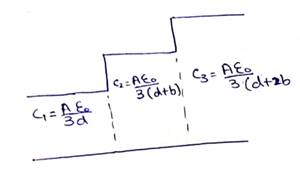
All capacitors are in parallel combination
![]()
![]()
![]()
Solution 18
(a) capacitance
![]()

C = 8pF
(b) Same as ratio of radii and length of cylinders are same,
C = 8pF
Solution 19
![]()
![]()
=20V
Solution 20
Initially ,

![]() Charge supplied by battery Q= CV
Charge supplied by battery Q= CV
Q=![]() =
= ![]() C
C
Now , when switch is closed , the capacitor gets short - circuited
![]() = 5+5 =10
= 5+5 =10![]() F
F
Charge supplied by battery ![]() V
V
= 10×50 = 500μC
Hence ,
Charge supplied = ![]() -Q
-Q
=![]() =
3.3
=
3.3![]() C
C
Solution 21
Potential drop on each
capacitor ![]()
Particle is in equilibrium then
Mg = qE
Mg
= q![]()
![]() = V
= V ![]()
V=
![]()
V = 43 m volt.
Solution 22
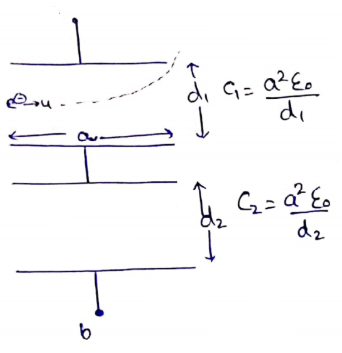
Potential
difference across ![]() will be inverse ratio as both are in series
combination
will be inverse ratio as both are in series
combination
![]()
![]() upper capacitor
upper capacitor
![]() =
= ![]() V
V
Electric field in upper capacitor
![]() =
=![]() =
=![]()
For electron
|
x-axis |
y-axis |
|
|
|
|
|
|
|
|
|
|
|
|
|
|
|
|
|
t=
|
|
|
|
|
u
= a |
|
|
u
= |
|
Capacitors Exercise 167
Solution 23
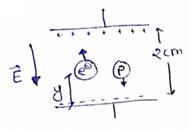
For electron,
![]()
![]()
![]()
![]()
![]() --------(1)
--------(1)
For proton,
![]()
![]()
![]()
![]()
![]() --------(2)
--------(2)
Divide (1) and (2)
![]()
![]()
Solution 24
All the circuits are in balanced wheat stone symmetry so no current flows is 5μF capacitor
![]()
Solution 25
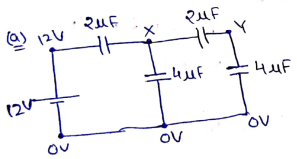
Nodal analysis at X
![]()
![]() --------------(1)
--------------(1)
Nodal analysis at y
![]()
![]() ---------------(2)
---------------(2)
Putting in (1)
![]()
![]()
So,
![]()
![]()
(b)
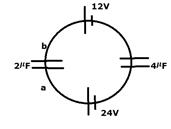
![]()
![]()
![]()
![]()
So,
![]()
(c)
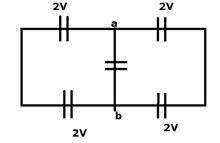
Nodal Analysis at X
![]()
![]()
![]()
![]()
So,
![]()
(d)
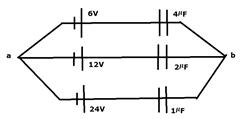
Nodal analysis at Vb
![]()
![]()
![]()
So,
![]()
![]()
Solution 26
(a) By input-output symmetry,
Potential difference across 1![]() F
must be same
F
must be same
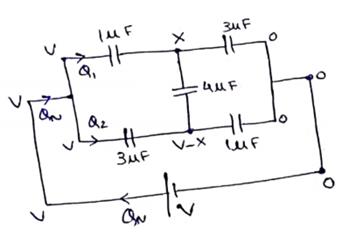
Nodal Analysis at X
![]()
![]()
![]()
For charge
![]()
![]()
For charge
![]()
![]()
Total charge flown=![]()
![]()
![]()
![]()
(b)
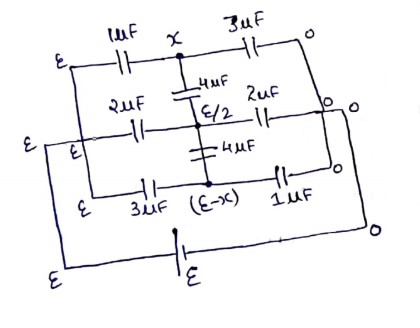
By input - output symmetry,
Potential difference across 1μF, will be same.
Potential difference across 2μF,
will be same and is equal to ![]() .
.
Nodal analysis at x
![]()
![]()
Current in 1μF
![]()
Current in 2μF
![]()
Current in 3μF
![]()
Current flown in battery =
![]()
![]()
![]()
(c)
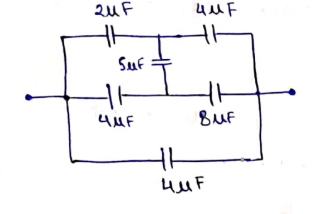
It is in wheat stone symmetry
So, 5![]() Capacitor is removed
Capacitor is removed
![]()
![]()
![]()
(d) It is in wheat stone symmetry
So, all 6![]() capacitors will be removed
capacitors will be removed
![]()
![]()
Solution 27
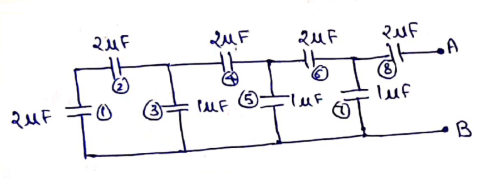
C1 and C2 are in series =![]()
This is in parallel with C3= 1+1=2![]()
This is in series with C4=![]()
This is in parallel with C5= 1+1=2![]()
This is in series with C6=![]()
This is in parallel with C7= 1+1=2![]()
This is in series with C8=![]()
![]()
Solution 28
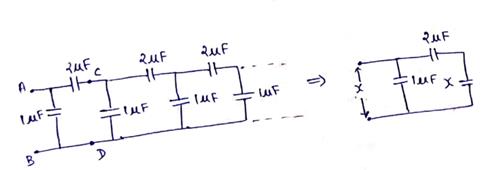
Let CAB=x then CCD=x
![]()
![]()
![]()
![]()
Therefore,
![]()
Solution 29
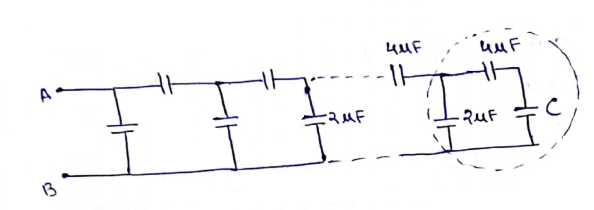
If capacitance of encircled part again comes C then it becomes independent of sections
![]()
![]()
![]()
![]()
![]()
(Not Possible)
Solution 30
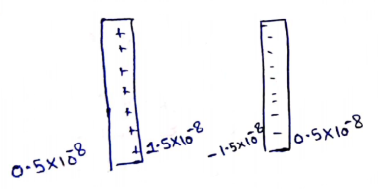
Charge on the outer faces of the
plates is average of all charges ![]()
=![]()
![]() =
0.5
=
0.5![]() C
C
![]() = 2
= 2![]() - 0.5×10-8
- 0.5×10-8
= 1.5![]()
Q=CV
1.5![]() V
V
V = 12.5 volt
Capacitors Exercise 168
Solution 31
Charge on each surface will be ![]() = 10μC to
have zero
= 10μC to
have zero
Electric field inside plate
Effective charge on the capacitor = 10μC
Q=CV
10μ = 10μV
V = 1volt
Solution 32
Outer plate will have average of charge
![]()
![]()
![]() = 1μC -
= 1μC - ![]()
=1-1.5
![]() = -0.5 μC
= -0.5 μC
Effective charge on the capacitor = -0.5μC
Q = CV
0.5=0.1(v)
V = 5 volt
Solution 33
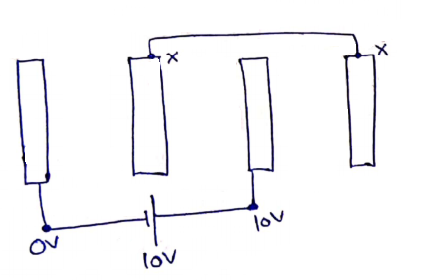
Capacitance between each plates is same
C=![]() =
= ![]()
C = 24![]() F
F
Nodal analytic at X
![]() = 0
= 0
3X =20
X = ![]()
Potential difference on each side of 10 V plate = 10 - X
=10 - ![]()
= ![]() volt
volt
Charge on each side = CV
=![]()
=8![]() C
C
Total charge supplied by battery = 2![]()
![]() C
C
=0.16μC
Solution 34
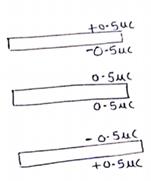
(a) To have zero electric field inside middle plate (1μC) is equally distributed on plate.
(b) ![]() =0.5μC
=0.5μC
Q = CV
0.5![]() -50
-50![]() V
V
V=10volt
Solution 35
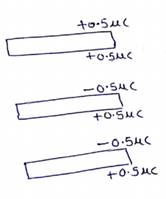
(a) ![]()
Q = CV
0.5 ![]() = 50
= 50![]()
V= 10volt
(b) ![]() C
C
Q = CV
0.5 ![]() = 50
= 50![]()
V=10volt
Solution 36
(a) ![]() =
= ![]() (series combination )
(series combination )
So, ![]() =
= ![]() =
= ![]()
Potential difference across 20pf = ![]() = 4.29V
= 4.29V
Potential difference across 50pf = 6-4.29 = 1.71 V
(b) energy stored in 20pf = ![]() C
C![]()
=![]() = 184pJ
= 184pJ
And in 50pF = ![]() = 73.5 pJ
= 73.5 pJ
Solution 37
![]() =
= ![]() = 2.4μF
= 2.4μF
Energy supplied by battery = Q×V
=C![]()
= ![]()
=960μJ
Solution 38
B and c are in parallel combination
![]() =
=![]()
=10+10
![]() 20μF
20μF
All are in series combination , is charge will be same on each
Q=CV
![]()
![]()
![]() =
= ![]() = 40V
= 40V
![]() =
= ![]() = 20V
= 20V
![]() =
=![]() = 40V
= 40V
Energy stored
![]() =
= ![]() =
= ![]() C
C![]() =
= ![]() = 8mJ
= 8mJ
![]() =
=![]() = 2mJ
= 2mJ
Solution 39
Initially , the potential on capacitor be V
![]() =
=![]() C
C![]() 4 J
4 J
Now ,
Energy loss ![]()
![]() = 2J
= 2J
Energy stored in two capacitors = 4J - 2J
=2J
Solution 40
![]()
=![]()
![]() = 4V
= 4V
(a) Charge on 2![]() =
= ![]() = 8
= 8 ![]()
And
4![]() =
= ![]() = 16
= 16![]()
(b) Energy stored =![]() C
C![]()
In
![]() =
=![]() = 16
= 16![]()
And
In ![]() =
=![]() = 32
= 32![]()
(c)
![]()
=
![]()
=96![]()
Solution 41
Capacitance of sphere = 4![]()
Energy
stored = ![]() C
C![]()
=![]()
![]()
Solution 42
![]() =
= ![]()
Energy stored in spherical shell f width dr at distance r
dU = ![]() .
.![]() dr
dr
U = ![]() =
= ![]()
U = ![]()
From R to 2R
![]() =
= ![]()
= ![]()
![]() =
= ![]() R
R![]()
![]() from 2R
from 2R ![]()
![]()
![]() R
R![]()
![]() .
.
Solution 43
![]() =
= ![]()
![]() =
= ![]() =
= ![]()
![]() =
= ![]()
Energy stored = 5.6 ![]() J
J
Solution 44
Initial capacitance ![]() =
= ![]()
= ![]()
![]() =1.77
=1.77![]() F
F
![]()
![]() =
= ![]()
= ![]()
![]() =0.88
=0.88![]() F
F
![]() charge flown =
charge flown =![]()
![]() (
(![]() V
V
![]() (0.88
(0.88![]() (12)
(12)
![]() C
C
![]() energy absorbed = (∆Q)(V)
energy absorbed = (∆Q)(V)
=![]()
![]() J
J
![]() =
= ![]() =
= ![]()
=![]() J
J
![]() =
= ![]() =
= ![]()
![]() 6.35
6.35![]() J
J
Work done = force × displacement
W = ![]() =
= ![]()
W = 6.35![]() J
J
Work done ![]()
So, no heat is parallel during transfer
Solution 45
(a) ![]() = C
= C![]()
= (100)(24)
![]() =2400
=2400![]()
![]() = C
= C![]()
![]() (100)(12)
(100)(12)
![]() =1200
=1200![]()
(b) charge flown = ![]()
= 2400-1200
=
1200![]()
(c) work is done on battery
W = charge × potential
= (1200μ)(12)
W = 14.4 mJ
(d)
![]() =
= ![]()
![]() =
= ![]()
![]()
=
21600![]()
![]() 21.6mJ
21.6mJ
![]() + heat loss
+ heat loss
![]() = 14.4 + heat loss
= 14.4 + heat loss
heat loss = 7.2mJ
Solution 46
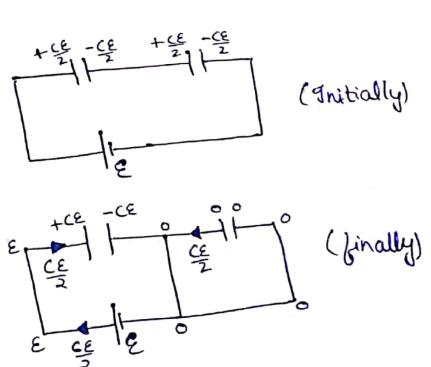
(a)
initially ![]() =
= ![]() =
= ![]()
And
charge flown = ![]()
Now, switch is closed
Charge
flown = ![]()
(b) work done = charge × potential
=
![]()
=
![]()
![]() =
=![]() =
= ![]()
![]() +
+![]() C
C ![]() =
= ![]()
![]()
![]()
![]()
(b) heat = work done - ∆U
![]()
Heat = ![]()
Capacitors Exercise 169
Solution 47
(a) Energy stored ![]()
In 5![]() =
= ![]() =
1.44 mJ
=
1.44 mJ
In 6![]() =
= ![]() = 0.432
mJ
= 0.432
mJ
(b) ![]()
![]()
![]()
![]() on 5
on 5![]() C
C![]() = 5
= 5 ![]() = 21.8
= 21.8![]()
![]() on 6
on 6![]() C
C![]() = 6
= 6 ![]() = 26.2
= 26.2![]()
(c) ![]()
![]()
![]() (d)
This energy is dissipated as heat.
(d)
This energy is dissipated as heat.
Solution 48

![]() = CV
= CV
![]()
![]() = 60μC
= 60μC
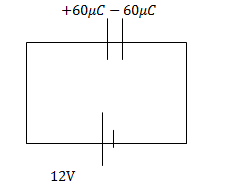
![]() = CV
= CV
![]()
![]() = 60μC
= 60μC
Now, charge flown through battery = 120μC
![]() +
heat produced = workdone
+
heat produced = workdone
![]() =
120×12
=
120×12
heat=1.44mJ
Solution 49
![]()
![]()
C= 1.42nF
Solution 50
(a) charge Q = CV
= ![]()
Q = 8.5nc
(b) induced charge on dielectric
![]() = Q
= Q![]()
![]()
![]() = 6.4nc
= 6.4nc
![]() = Q -
= Q - ![]()
![]() - 6.4
- 6.4
![]() .1nc
.1nc
Solution 51
capacitance
![]()
K = ∞ ( metal )
![]()
C = 88pF
Solution 52
![]() = c;
= c; ![]() = V
= V
![]()
![]() cv (i)
cv (i)
![]() = c;
= c; ![]() = V
= V
![]()
![]() = CKV
= CKV
![]() CKV (ii)
CKV (ii)
divided (ii) by (i)
k=3
Solution 53
(a) charge Q = VC
=(5)(6)
![]() = 30
= 30![]()
(b) electric field = ![]()
= ![]() = 300
= 300![]()
(c) new capacitance ![]() =
= ![]()
Divide ![]() =
= ![]()
![]() =
= ![]()
![]() = 8.33μF
= 8.33μF
(d) final charge on capacitor ![]() =
=![]() V
V
= ![]()
![]() = 50μC
= 50μC
So, charge flown = ![]() =
= ![]()
= ![]()
=20![]()
Solution 54
capacitance = ![]()

=44.25pF
Solution 55
initial capacitance
![]() =
= ![]() =
= ![]()
![]() = 3.54
= 3.54![]() F
F
![]()
![]() =
= ![]() =
= ![]()
![]() =
= ![]() F
F
(a) change in energy stored
![]() -
- ![]()
![]()
![]() 1.18
1.18![]()
(b) charge on capacitor when dielectric is inside
![]()
=![]()
Q = ![]() C
C
Now , battery is disconnected , then charge will remain constant energy stored
U = ![]()
![]() =
= ![]()
![]() =
= ![]()
∆U = ![]()
∆U = 1.92 ![]()
(c) during insertion capacitance increases , more charge flows from battery and hence battery supplies energy
During removal, energy increases, work has to be external agent to remove it.
Solution 56
(a) The two parts of the capacitor are in series with capacitance C1 and C2
![]()
![]()
As they are connected in series the net capacitance would be
![]()
On substituting the value we get
![]()
(b) Here the Capacitor has three parts and are connected in series
![]()
![]()
![]()
![]()
On substituting values
![]()
(c)
![]()
![]()
These two are in parallel
C = C1+C2
![]()
Solution 57
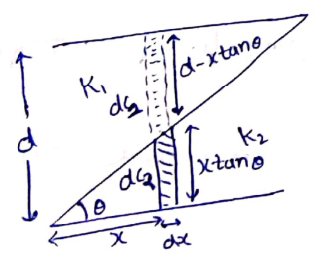
Elemental capacitor of width dx is assumed at distance from left end
d![]() =
= ![]() ; d
; d![]() =
= ![]()
Both are in series , so equivalent capacitance is given by
![]()
![]()
![]()
C
= ![]()

=
![]() ln
ln![]()
C
= ![]() ln
ln![]() =
= ![]()
C
= ![]()
Solution 58
Initially
![]() =
= ![]() ;
; ![]() =
= ![]()
And
energy stored ![]() =
= ![]() C
C![]() +
+ ![]() C
C![]() = C
= C![]()
Now ,
![]() = 3c
= 3c
Charge
and potential will remain constant for ![]() and
and ![]() respectively
respectively
![]() =
= ![]() +
+ ![]()
![]() +
+ ![]()
![]() =
= ![]()
So,

Solution 59
Initially charge ![]() CV
CV
Energy stored initially ![]() C
C![]()
![]()
Now, when battery is disconnected charge
remains constant. ![]()
![]() = KC
= KC
![]()
![]()
![]()
Work done = change in energy
= ![]()
W = ![]()
Solution 60
(a) charge Q = CV
![]()
Q = 5mc
(b) charge remains constant ![]() = Q
= Q
![]()
![]()
![]() =20V
=20V
(c) charge = CV
![]()
(d) qin = q ![]()
=5![]()
qin =3mc
Solution 61
One capacitor made by shells a and c and other capacitor by the shells b and c
![]() =
= ![]() ;
; ![]() =
= ![]()
![]()
![]()
![]()
![]()
Capacitors Exercise 170
Solution 62
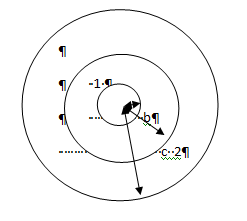
![]()
![]()
![]()
Solution 63
![]()
![]()
![]()
![]()
Solution 64
![]()
![]()
![]()
![]()
Solution 65
![]()
C = ![]()
Charge = Q = CV
=![]()
Q = 212.4![]() C
C
Force = ![]()
=![]()
Force = 2.5![]() N
N
Solution 66
Let the length of the part of slab inside the capacitor be x

Capacitance of air capacitor ![]() =
= ![]()
And dielectric capacitor ![]() =
= ![]()
Both are in parallel combination
![]()
![]()
![]()
Energy stored =![]()
![]()
Force by capacitor on plate
![]()
![]()
![]()
Since it is in equilibrium
![]()
![]()
![]()
Solution 67

For left capacitor , ![]() are in parallel combination
are in parallel combination
![]()
![]()
![]()
![]()
![]()
![]()
![]()
Similarly by right side capacitor
![]()
Now , dielectric is in equilibrium
![]()

Solution 68

Let at any time dielectric is x length inside plates
Width of plate =![]()
Capacitance,
![]()
![]()
Both are in parallel combination
![]()
![]()
Force by capacitor
![]()
![]()
![]()
Negative shows that's force is in inside direction of capacitor.
Velocity of slabs increases till it comes completely inside the slab and then again decrease as when slab comes out force is inside the capacitor.
So, it performs periodic motion.
Time to come completely inside slab
U=0; s=(l-a); acc =![]()
![]()
![]()

For oscillation,
Time periods=4t





